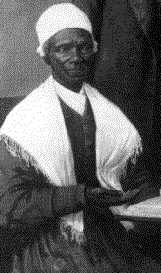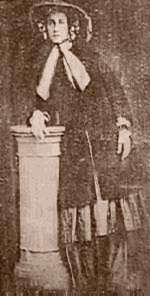Readings:
Esther 1:1-21
Psalm 146
1 Peter 4:10-11
Luke 11:5-10Preface of Baptism
[Common of a Prophetic Witness]
[For Prophetic Witness in Society]
PRAYER (traditional language):
O God, whose Spirit guideth us into all truth and maketh
us free: Strengthen and sustain us as thou didst thy servants Elizabeth,
Amelia, and Sojourner. Give us vision and courage to stand against
oppression and injustice and all that worketh against the glorious liberty
to which thou callest all thy children; through Jesus Christ our Savior,
who liveth and reigneth with thee and the Holy Spirit, one God, for ever
and ever. Amen.
PRAYER (contemporary language):
O God, whose Spirit guides us into all truth and makes us
free: Strengthen and sustain us as you did your servants Elizabeth, Amelia,
and Sojourner. Give us vision and courage to stand against oppression
and injustice and all that works against the glorious liberty to which
you call all your children; through Jesus Christ our Savior, who lives
and reigns with you and the Holy Spirit, one God, for ever and ever. Amen.
Lessons revised in Lesser Feasts & Fasts 2024.
Return to Lectionary Home Page
Webmaster: Charles Wohlers
Last updated: 9 July 2024
ELIZABETH CADY STANTON,
AMELIA BLOOMER,
SOJOURNER TRUTH:
SOCIAL REFORMERS
The Episcopal Church has added to its Calendar three American women who were
pioneers in the struggle for black emancipation and for women's votes. The
date chosen for commemorating them is the anniversary of the Women's Rights
Convention held in Seneca Falls, New York, 19-20 July 1848.
SOJOURNER TRUTH (26 NOV 1883)
 Sojourner
Truth, originally known as Isabella, was born a slave in New York in about
1798. In 1826 she escaped with the aid of Quaker Abolitionists, and became
a street-corner evangelist and the founder of a shelter for homeless women.
When she was travelling, and someone asked her name, she said "Sojourner,"
meaning that she was a citizen of heaven, and a wanderer on earth. She
then gave her surname as "Truth," on the grounds that God was her Father,
and His name was Truth. She spoke at numerous church gatherings, both
black and white, quoting the Bible extensively from memory, and speaking
against slavery and for an improved legal status for women. The speech
for which she is best known is called, "Ain't I a Woman?" It was delivered
in response to a male speaker who had been arguing that the refusal of
votes for women was grounded in a wish to shelter women from the harsh
realities of political life. She replied, with great effect, that she
was a woman, and that society had not sheltered her. She became known
as "the Miriam of the Latter Exodus."
Sojourner
Truth, originally known as Isabella, was born a slave in New York in about
1798. In 1826 she escaped with the aid of Quaker Abolitionists, and became
a street-corner evangelist and the founder of a shelter for homeless women.
When she was travelling, and someone asked her name, she said "Sojourner,"
meaning that she was a citizen of heaven, and a wanderer on earth. She
then gave her surname as "Truth," on the grounds that God was her Father,
and His name was Truth. She spoke at numerous church gatherings, both
black and white, quoting the Bible extensively from memory, and speaking
against slavery and for an improved legal status for women. The speech
for which she is best known is called, "Ain't I a Woman?" It was delivered
in response to a male speaker who had been arguing that the refusal of
votes for women was grounded in a wish to shelter women from the harsh
realities of political life. She replied, with great effect, that she
was a woman, and that society had not sheltered her. She became known
as "the Miriam of the Latter Exodus."
ELIZABETH CADY STANTON (26 Oct 1902)
 Mrs.
Stanton was born in 1815 and reared in the Presbyterian Church. She found
the Calvinist doctrine of predestination dismaying, and rebelled against
it. She denounced the clergy of her day for not upholding women's
rights, but as she travelled giving speeches on the subject, she found
no lack of pulpits available to her. She undertook to write what she called
a Women's Bible. It never got beyond a series of notes on selected Biblical
passages. For example, she quotes the passage in Genesis where we
are told that Noah's Ark had only one window, and remarks that if a woman
had been consulted, the Ark would have been better designed.
Mrs.
Stanton was born in 1815 and reared in the Presbyterian Church. She found
the Calvinist doctrine of predestination dismaying, and rebelled against
it. She denounced the clergy of her day for not upholding women's
rights, but as she travelled giving speeches on the subject, she found
no lack of pulpits available to her. She undertook to write what she called
a Women's Bible. It never got beyond a series of notes on selected Biblical
passages. For example, she quotes the passage in Genesis where we
are told that Noah's Ark had only one window, and remarks that if a woman
had been consulted, the Ark would have been better designed.
Reading Mrs. Stanton's life and works, I have
an uncomfortable feeling that she was interested in "religion" only as
a potential ally or opponent in her campaign for women's political equality.
I once spent some time in a congregation where the preacher never mentioned
God or Christ except when they could be quoted in support of the preacher's
political agenda. It was not a good experience. For me, reading about
Mrs Stanton moves me, not to say, "Lord, give me the grace to follow you,
as you did to Mrs. Stanton," but rather, "Lord do I do that? Do I
think of you as there to carry out my agenda? If so, then help me to recognize
it and to stop it." Meanwhile, if we think that the abolition of slavery
and the recognition of women's right to own property are in accordance
with justice, and are accordingly good things, then we can thank God for
accomplishing good through Mrs Stanton and others. "It is enough to be
sure of the deed. Our courteous Lord will deign to redeem the motive."
(Julian of Norwich)
AMELIA JENKS BLOOMER (30 DEC 1894)
 Amelia
Jenks was born in New York in 1818, reared as a Presbyterian, and as a
young woman became an activist for the anti-slavery, anti-alcohol, and
women's votes movements. One of her concerns has made her name a part
of the language. In her day, women's fashions encouraged tightly laced
waists, involving severe health problems. (The fashions were denounced
in 1728 by William Law--see 9 April.) The
fashion also called for skirts trailing the ground, an arrangement that
made it difficult to keep the skirts reasonably clean, especially since
the streets were full of horses. Mrs. Bloomer designed a women's costume
featuring what are known as Turkish pants, or harem pants (remember the
television show I Dream of Jeannie), loose baggy trousers gathered
into tight bands at the ankles and waist. Over these she wore a mid-calf-length
skirt. It seems a thoroughly modest garb, but it excited indignation and
ridicule. (At least well into the 1940's, women's underpants, and women's
baggy outer pants worn for athletics, were known as "bloomers.")
Amelia
Jenks was born in New York in 1818, reared as a Presbyterian, and as a
young woman became an activist for the anti-slavery, anti-alcohol, and
women's votes movements. One of her concerns has made her name a part
of the language. In her day, women's fashions encouraged tightly laced
waists, involving severe health problems. (The fashions were denounced
in 1728 by William Law--see 9 April.) The
fashion also called for skirts trailing the ground, an arrangement that
made it difficult to keep the skirts reasonably clean, especially since
the streets were full of horses. Mrs. Bloomer designed a women's costume
featuring what are known as Turkish pants, or harem pants (remember the
television show I Dream of Jeannie), loose baggy trousers gathered
into tight bands at the ankles and waist. Over these she wore a mid-calf-length
skirt. It seems a thoroughly modest garb, but it excited indignation and
ridicule. (At least well into the 1940's, women's underpants, and women's
baggy outer pants worn for athletics, were known as "bloomers.")
Mrs. Bloomer and her husband eventually settled in
Council Bluffs, Iowa, where she worked to promote churches, schools,
libraries, and progressive and reform movements. On one occasion
she said:
"The same Power that brought the slave out of bondage
will, in His own good time and way, bring about the emancipation of women,
and make her the equal in power and dominion that she was in the
beginning."
by James Kiefer